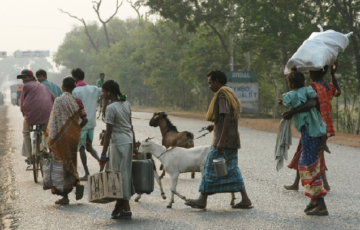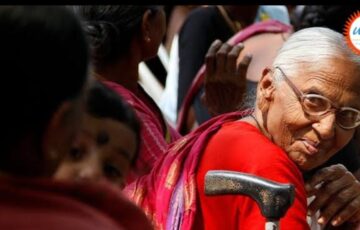Secularism
Q. What do you mean by an Indian form of secularism? Rising communal violence and the politics of voting are a threat to secularism in India. Elaborate.
Approach
|
Secularism is the principle that makes a state neutral in the matter of religion and hence does not uphold any particular religion as the state religion, for example, USA and India. Principled distance from religion is the essence of Indian secularism. The 42nd amendment of the Constitution of India, amended the Preamble of the Constitution declaring India as a secular nation. In India secularism means the state views all religions as equal.
Various features of Indian concept of secularism
- Positive concept: Indian Constitution embodies the positive concept of secularism, i.e. giving equal respect to all religions or protecting all religions equally. The Western concept of secularism connotes a complete separation between the religion and the state.
- Basic feature of Indian constitution: Secularism is one of the basic features of the Constitution. In a landmark judgment in the Bommai case (1994), the Supreme Court upheld that secularism is a ‘basic feature’ of the Constitution. Hence, a state government pursuing anti-secular politics is liable to action under Article 356.
- Concurrent power: The 7th schedule of Indian constitution places religious institutions, charities and trusts into concurrent List, which means that both the central government of India and various state governments in India can make their own laws about religious institutions, charities and trusts.
- Equality: The Constitution of India does not uphold any particular religion as the official religion of the Indian State. It prevents the State from discriminating against any citizen on the grounds of religion (Article 15).
- Focus on Harmony: Indian secularism focuses on harmony among all religions rather than tight separation between state and religion. It allows the state to prevent conflicts on the basis of religion through timely interventions which would have been disastrous for the state if not controlled.
- Room for religious reforms: Indian secularism is broader in a sense that it allows state intervention to help reform various evils and superstitions. E.g. Many rules in Karnataka allowed the government to curb superstitions that were against human rights.
- Protect rights over religion: By accepting community-based rights for religious minorities, the state can protect the rights of Indian citizens. All persons are equally entitled to freedom of conscience and the right to freely profess, practice and propagate any religion (Article 25).
- Tolerance: By acceptance of all religions rather than tight separation it reflects tolerant attitude of state and its people.
- Liberal: Many religiously sanctioned social practices are oppressive by virtue of their illiberal and non-egalitarian character and deny a life of dignity and self-respect. Therefore, Indian secularism helps liberal and egalitarian principles by reforming such practices through state intervention. E.g. recent Triple Talaq Act.
- Communal violence: Communal violence constitutes a type of collective aggression that emerges from confrontations between groups of varying religious, ethnic, linguistic, or regional affiliations.
Causes of Communal Violence in India
- The involvement of political parties and leaders in exploiting communal sentiments to achieve electoral advantages or ideological objectives.
- Employment of communal polarization as a tactic to foster division and control.
- The persistence of ingrained biases and misconceptions against diverse communities.
- The absence of cross-community discussions and confidence.
- The impact of radical groups and entities that disseminate communal animosity and aggression.
- The rivalry for limited resources and openings among various communities.
- The sense of relative lack or bias perceived by marginalized factions.
- The collision of values and ways of life among different communities.
- The gradual decline of cultural variety and diversity.
Major examples of Communalism affecting Secularism
There have been several major occurrences of communalism in India throughout history, some examples include
- The Partition of India in 1947: One of the most significant events in India’s history, the partition led to the creation of Pakistan and resulted in widespread communal violence and displacement of millions of people.
- Anti-Sikh Riots: In October 1984, the anti-Sikh riots broke out after the assassination of Indira Gandhi, where more than 4000 Sikhs were killed in Delhi, Uttar Pradesh, and other parts of India.
- The Babri Masjid demolition in 1992: The destruction of the Babri Masjid, a 16th-century mosque in Ayodhya, by a mob of Hindu nationalists led to widespread communal riots across India, resulting in the deaths of over 2,000 people.
- The Gujarat riots of 2002: A series of violent communal riots in the Indian state of Gujarat resulted in the deaths of over 1,000 people and the displacement of over 150,000 people.
- Assam Violence 2012: Violence broke out due to ongoing tensions between the Bodos and Bengali-speaking Muslims. These tensions stemmed from competition for resources, land, and political influence.
- The Muzaffarnagar riots of 2013: A series of violent communal riots in Uttar Pradesh resulted in the deaths of over 60 people and the displacement of over 50,000 people.
- The Delhi riots of 2020: A major communal violence broke out in New Delhi, in February 2020. The violence resulted in the deaths of over 50 people and injuries to hundreds more, as well as the displacement of thousands of people.
Steps need to be taken to address the issues pertaining to communalism in India
Addressing the issues of communalism in India is a complex and multi-faceted task that requires a combination of short-term and long-term strategies. Some steps that could be taken to address the issues of communalism in India include:
- Promoting social harmony and understanding: Encouraging interfaith dialogue, cultural exchange programs, and educational initiatives that promote understanding and respect for different communities can help to reduce communal tensions.
- Addressing socio-economic inequalities: such as poverty, unemployment, and lack of access to resources, can help to reduce the competition between different communities for scarce resources and thus reduce communal tensions.
- Holding political leaders accountable: Holding political leaders and parties accountable for divisive rhetoric and communal actions can help to reduce the use of communal ideologies for political gain.
- Media monitoring: Monitoring and regulating the media to prevent the spread of misinformation and hate speech can help to reduce communal tensions.
- Implementing legal measures: Implementing legal measures to punish those who incite violence and discrimination based on communal identity can help to reduce communal tensions.
- Addressing historical issues: Addressing historical injustices and conflicts can help to reduce communal tensions.
- Promoting secularism: Promoting secularism, where the state is neutral towards all religions, can help reduce communal tensions.
It’s important to note that addressing communalism is a long-term process and requires the involvement of various stakeholders, including the government, civil society, media, and the public. It also requires a holistic approach that addresses the root causes of communalism and its different dimensions, and it’s not a one size fits all solution.









